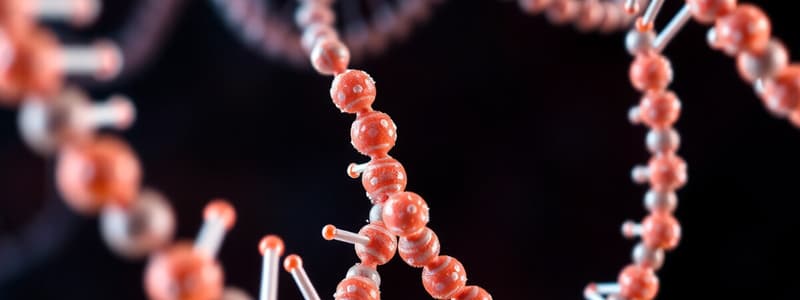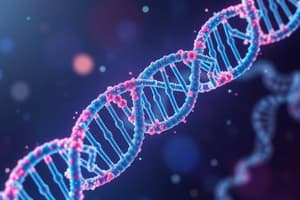Podcast
Questions and Answers
What is the primary biological role of nucleic acids?
What is the primary biological role of nucleic acids?
- Cellular respiration
- Protein synthesis
- Information storage and transfer (correct)
- Energy storage
Which type of nucleotide consists of a nitrogenous base, a sugar, and a phosphate group?
Which type of nucleotide consists of a nitrogenous base, a sugar, and a phosphate group?
- Nuclein
- Nucleotide (correct)
- Nucleoside
- Nucleosome
Which of the following statements is true regarding purine biosynthesis?
Which of the following statements is true regarding purine biosynthesis?
- Purine biosynthesis is not regulated.
- Purines are synthesized only in the mitochondria.
- Purines are exclusively synthesized from nucleotides.
- Purine biosynthesis involves several enzymatic steps. (correct)
What is the function of ribonucleotide reductase in nucleotide metabolism?
What is the function of ribonucleotide reductase in nucleotide metabolism?
Which disorder is commonly associated with defects in purine metabolism?
Which disorder is commonly associated with defects in purine metabolism?
What is the primary cause of gout?
What is the primary cause of gout?
What is the role of allopurinol in the treatment of gout?
What is the role of allopurinol in the treatment of gout?
What is a notable neurological symptom associated with Lesch-Nyhan Syndrome?
What is a notable neurological symptom associated with Lesch-Nyhan Syndrome?
What enzyme activity is affected in Lesch-Nyhan Syndrome?
What enzyme activity is affected in Lesch-Nyhan Syndrome?
What percentage of autistic patients is estimated to overproduce purines?
What percentage of autistic patients is estimated to overproduce purines?
What type of sugar is found in nucleosides?
What type of sugar is found in nucleosides?
Which nucleotide modification properly describes a triphosphate?
Which nucleotide modification properly describes a triphosphate?
Which nitrogenous base is a purine?
Which nitrogenous base is a purine?
What is the bonding position for purines with sugars?
What is the bonding position for purines with sugars?
What is unique about the structure of 2’-Deoxyribose compared to D-Ribose?
What is unique about the structure of 2’-Deoxyribose compared to D-Ribose?
What is the first product synthesized in pyrimidine ribonucleotide synthesis?
What is the first product synthesized in pyrimidine ribonucleotide synthesis?
Which of the following substrates contributes to the pyrimidine ring during its synthesis?
Which of the following substrates contributes to the pyrimidine ring during its synthesis?
What role does OPRT play in the synthesis of UMP?
What role does OPRT play in the synthesis of UMP?
Which statement accurately describes the enzyme OMP decarboxylase?
Which statement accurately describes the enzyme OMP decarboxylase?
What is the significance of channeling in pyrimidine synthesis?
What is the significance of channeling in pyrimidine synthesis?
What role does the binding energy between OMP and the active site play during the reaction?
What role does the binding energy between OMP and the active site play during the reaction?
Which enzyme is responsible for catalyzing the transfer of Pi to UMP to form UDP?
Which enzyme is responsible for catalyzing the transfer of Pi to UMP to form UDP?
How does regulation of pyrimidine synthesis differ between bacteria and animals?
How does regulation of pyrimidine synthesis differ between bacteria and animals?
What is a consequence of adenosine deaminase (ADA) deficiency?
What is a consequence of adenosine deaminase (ADA) deficiency?
Which molecule inhibits carbamoyl phosphate synthetase II in animals?
Which molecule inhibits carbamoyl phosphate synthetase II in animals?
What does deoxyribonucleotide formation primarily depend on?
What does deoxyribonucleotide formation primarily depend on?
What enzymatic activity is associated with the α/β barrel domain structure found in adenosine deaminase?
What enzymatic activity is associated with the α/β barrel domain structure found in adenosine deaminase?
What is the fate of uracil in the liver?
What is the fate of uracil in the liver?
What distinguishes ribonucleotides from deoxyribonucleotides?
What distinguishes ribonucleotides from deoxyribonucleotides?
Which type of nucleoside ends with the suffix '-dine'?
Which type of nucleoside ends with the suffix '-dine'?
How is ATP uniquely involved in the first step of purine nucleotide synthesis?
How is ATP uniquely involved in the first step of purine nucleotide synthesis?
Which of the following is a precursor for both purine and pyrimidine synthesis?
Which of the following is a precursor for both purine and pyrimidine synthesis?
What is the first purine derivative formed during purine nucleotide synthesis?
What is the first purine derivative formed during purine nucleotide synthesis?
Which molecules exhibit negative feedback on Ribose Phosphate Pyrophosphokinase?
Which molecules exhibit negative feedback on Ribose Phosphate Pyrophosphokinase?
What is the significance of channeling in the IMP synthesis pathway?
What is the significance of channeling in the IMP synthesis pathway?
What does the hydrolysis of PPi to 2Pi signify in purine synthesis?
What does the hydrolysis of PPi to 2Pi signify in purine synthesis?
Which molecules are involved in the reciprocal control of purine nucleotide biosynthesis?
Which molecules are involved in the reciprocal control of purine nucleotide biosynthesis?
Which metabolite is a secondary product formed during purine catabolism?
Which metabolite is a secondary product formed during purine catabolism?
What happens to nucleotides during digestion in the intestine?
What happens to nucleotides during digestion in the intestine?
Which component of the purine ring is derived from bicarbonate ion?
Which component of the purine ring is derived from bicarbonate ion?
What does the term 'feedforward activation’ refer to in relation to purine biosynthesis?
What does the term 'feedforward activation’ refer to in relation to purine biosynthesis?
Flashcards
Nucleic Acid Structure
Nucleic Acid Structure
Nucleic acids are made of nucleotides, which consist of a nitrogenous base, a sugar, and a phosphate group.
DNA Role
DNA Role
DNA stores genetic information, directing protein synthesis
RNA Role
RNA Role
RNA helps in protein synthesis and other cellular processes.
Purine/Pyrimidine Metabolism
Purine/Pyrimidine Metabolism
Signup and view all the flashcards
Ribonucleotide Reductase Role
Ribonucleotide Reductase Role
Signup and view all the flashcards
Nitrogenous Bases
Nitrogenous Bases
Signup and view all the flashcards
Purine vs. Pyrimidine
Purine vs. Pyrimidine
Signup and view all the flashcards
Sugar Numbering
Sugar Numbering
Signup and view all the flashcards
Nucleoside Formation
Nucleoside Formation
Signup and view all the flashcards
Nucleotide Formation
Nucleotide Formation
Signup and view all the flashcards
Gout
Gout
Signup and view all the flashcards
Uric Acid Excretion
Uric Acid Excretion
Signup and view all the flashcards
Xanthine Oxidase
Xanthine Oxidase
Signup and view all the flashcards
Allopurinol
Allopurinol
Signup and view all the flashcards
Lesch-Nyhan Syndrome
Lesch-Nyhan Syndrome
Signup and view all the flashcards
UMP Synthesis
UMP Synthesis
Signup and view all the flashcards
Pyrimidine Synthesis Steps
Pyrimidine Synthesis Steps
Signup and view all the flashcards
OMP Decarboxylase Role
OMP Decarboxylase Role
Signup and view all the flashcards
Dihydroorotate Dehydrogenase Localization
Dihydroorotate Dehydrogenase Localization
Signup and view all the flashcards
Channeling in Pyrimidine Synthesis
Channeling in Pyrimidine Synthesis
Signup and view all the flashcards
Preferential Transition State Binding
Preferential Transition State Binding
Signup and view all the flashcards
UMP to UTP
UMP to UTP
Signup and view all the flashcards
Regulation of Pyrimidine Synthesis
Regulation of Pyrimidine Synthesis
Signup and view all the flashcards
Pyrimidine Degradation
Pyrimidine Degradation
Signup and view all the flashcards
Deoxyribonucleotide Formation
Deoxyribonucleotide Formation
Signup and view all the flashcards
Adenosine Deaminase (ADA)
Adenosine Deaminase (ADA)
Signup and view all the flashcards
ADA Deficiency and SCID
ADA Deficiency and SCID
Signup and view all the flashcards
What are Nucleotides?
What are Nucleotides?
Signup and view all the flashcards
What are some key roles of Nucleotides?
What are some key roles of Nucleotides?
Signup and view all the flashcards
What is the difference between DNA and RNA?
What is the difference between DNA and RNA?
Signup and view all the flashcards
How do we name Nucleosides?
How do we name Nucleosides?
Signup and view all the flashcards
How do we name Nucleotides?
How do we name Nucleotides?
Signup and view all the flashcards
What is de novo synthesis?
What is de novo synthesis?
Signup and view all the flashcards
What is the first purine derivative formed during de novo synthesis?
What is the first purine derivative formed during de novo synthesis?
Signup and view all the flashcards
Where do the atoms of the purine ring originate?
Where do the atoms of the purine ring originate?
Signup and view all the flashcards
What is the role of ATP in the first step of purine synthesis?
What is the role of ATP in the first step of purine synthesis?
Signup and view all the flashcards
What is channeling in metabolic pathways?
What is channeling in metabolic pathways?
Signup and view all the flashcards
How is IMP converted to AMP?
How is IMP converted to AMP?
Signup and view all the flashcards
How is IMP converted to GMP?
How is IMP converted to GMP?
Signup and view all the flashcards
What is reciprocal control in purine biosynthesis?
What is reciprocal control in purine biosynthesis?
Signup and view all the flashcards
How does PRPP regulate purine biosynthesis?
How does PRPP regulate purine biosynthesis?
Signup and view all the flashcards
How is purine biosynthesis controlled above the level of IMP?
How is purine biosynthesis controlled above the level of IMP?
Signup and view all the flashcards
Study Notes
Nucleic Acids - Chemistry, Function, & Metabolism
- Learning Objectives: Discuss the structure of nitrogenous bases, the biological roles of DNA and RNA, and associated disorders.
- Topic Outcomes:
- Describe the structure, function, and biological role of nucleosides, nucleotides, and their analogues.
- Describe the structure, function, and types of nucleic acids (DNA and RNA).
- Explain purine and pyrimidine biosynthetic pathways and their regulation.
- Explain the role of ribonucleotide reductase.
- Describe disorders associated with purine and pyrimidine metabolism.
Nitrogenous Bases
- Planar, aromatic, and heterocyclic structures
- Derived from purine or pyrimidine
- Base numbering is "unprimed"
- Includes: Adenine (A), Guanine (G), Cytosine (C), Thymine (T), and Uracil (U).
Sugars
- Pentoses (5-carbon sugars)
- Numbering of sugars is "primed"
- Includes D-Ribose and 2'-Deoxyribose
- 2'-Deoxyribose lacks a 2' hydroxyl group.
Nucleosides
- Result from linking a sugar (ribose or deoxyribose) with a purine or pyrimidine base through an N-glycosidic linkage.
- Purines bond to the 1' carbon at the N9 position.
- Pyrimidines bond to the 1' carbon at the N1 position.
Nucleotides
- Result from linking one or more phosphates to a nucleoside through esterification at the 5' end of the sugar.
- Phosphates can be bonded to either C3 or C5 atoms.
- Forms mono-, di-, or triphosphates.
- Examples: Adenosine Monophosphate (AMP), 2'-Deoxythymidine Monophosphate.
Nucleotides (continued)
- Monomers for nucleic acid polymers
- Important energy carriers (ATP, GTP)
- Components of coenzymes (FAD, NAD+, Coenzyme A)
- RNA is a polymer of ribonucleotides.
- DNA is a polymer of deoxyribonucleotides.
- Both DNA and RNA contain Adenine, Guanine, and Cytosine.
- Ribonucleotides contain Uracil.
- Deoxyribonucleotides contain Thymine.
Naming Conventions
- Nucleosides: Purine nucleosides end in "-sine" (e.g., adenosine, guanosine); Pyrimidine nucleosides end in "-dine" (e.g., thymidine, cytidine, uridine).
- Nucleotides: Add "mono-," "di-," or "triphosphate" to the nucleoside name (e.g., adenosine monophosphate, cytidine triphosphate).
Nucleotide Metabolism
- Purine Ribonucleotides: Formed de novo; first purine derivative is Inosine Monophosphate (IMP).
- Purine ring components are derived from aspartate, glutamine, glycine, and formate.
- AMP and GMP are formed from IMP.
Purine Nucleotides
- Purine ring components are derived from aspartate, formate, glutamine, and glycine.
- Uric acid is a final breakdown product.
Purine Nucleotide Synthesis
- ATP plays a key role
- PRPP is a precursor to pyrimidine, histidine, and tryptophan synthesis
- Channeling reactions help increase overall rate.
IMP Conversion to AMP and GMP
- Different pathways for AMP and GMP synthesis from IMP.
- Requires different enzymes and energy sources
Regulatory Control of Purine Nucleotide Biosynthesis
- GTP plays a role in AMP synthesis, and ATP plays a role in GMP synthesis (reciprocal control).
- PRPP is a central molecule in the pathway, and its levels affect the entire process.
- Feedback inhibition by nucleotides (ADP, GDP, AMP, GMP, and others)
- Some enzymes have allosteric sites on multiple nucleotides, for regulation
Purine Catabolism and Salvage
- Ingested nucleic acids are degraded to nucleotides by pancreatic enzymes and intestinal enzymes in the intestine.
- Nucleosides are then absorbed and further degraded.
- Uric acid is the primary end product in humans.
- Salvage pathways allow the organism to reuse bases and nucleotides.
Intracellular Purine Catabolism
- Nucleotides are broken down to nucleosides by 5'-nucleotidase.
- Purine nucleoside phosphorylase (PNP) and other enzymes convert nucleosides into bases like hypoxanthine, xanthine, and guanine.
- Xanthine is oxidized to uric acid by xanthine oxidase.
Xanthine Oxidase
-
A homodimeric protein that contains electron transfer proteins, FAD, and a Mo-pterin complex.
-
Catalyzes the conversion of xanthine to uric acid.
-
Transfers electrons to oxygen; generates hydrogen peroxide (H₂O₂), which is toxic.
-
H₂O₂ is further converted to oxygen and water by catalase.
-
The Purine Nucleotide Cycle*
-
A cycle involves the conversion of AMP to IMP and back.
-
Aspartate is deaminated to fumarate during the cycle.
Uric Acid Excretion
- Humans excrete uric acid crystals in urine.
- Birds, reptiles, and some insects excrete uric acid as insoluble crystals (paste form).
- High concentrations of uric acid in humans or animals may cause kidney stones
Purine Salvage
- Adenine phosphoribosyl transferase (APRT) and hypoxanthine-guanine phosphoribosyl transferase (HGPRT) catalyze the addition of a ribose-phosphate to free bases..
- This allows the reuse of purine bases.
Gout
- Gout arises from impaired excretion or overproduction of uric acid.
- Uric acid crystals can accumulate in joints, causing inflammation.
Allopurinol
- Allopurinol is a xanthine oxidase inhibitor that is used to treat gout.
- It inhibits uric acid formation.
Lesch-Nyhan Syndrome
- A genetic disorder caused by deficient HGPRT.
- Leads to increased levels of uric acid and neurological symptoms such as spasticity, aggression, and self-harm.
Purine Autism
- High levels of purine production may be present in 25% of the autistic population.
Pyrimidine Ribonucleotide Synthesis
- Uridine monophosphate (UMP) is synthesized first.
- CTP is synthesized from UMP.
- Pyrimidine ring is first synthesized; then attached to ribose-5-phosphate.
Pyrimidine Synthesis
- 2 ATP and bicarbonate needed in first step.
- Condensation Reactions between Carbamoyl Phosphate and Aspartate; forming Dihydroorotate;
- Final Reaction is catalyzed by OMP Decarboxylase; releasing CO2
UMP Synthesis Overview
- 2 ATPs are required, one is used in the initial step.
- Two reactions form carbamoyl aspartate and dihydroorotate.
- Dehydrogenase converts the reaction to orotate to orotate monophosphate.
- Ribose attaches to the orotate by Phosphoribosyl transferase forming orotidylate
- This molecule is then converted to UMP.
OMP Decarboxylase
- This enzyme is extremely efficient, with high catalytic proficiency.
UTP and CTP Synthesis
- Nucleoside monophosphate kinases convert UMP to UDP and then UTP.
- CTP is generated from UTP.
- Glutamine contributes to the amide nitrogen for the process.
Regulatory Control of Pyrimidine Synthesis
- Bacteria and animals differ in their regulatory mechanisms.
- UDP and UTP inhibit carbamoyl phosphate synthetase II, one of the rate-limiting enzymes.
- ATP and PRPP can activate the enzyme, promoting pyrimidine synthesis.
Degradation of Pyrimidines
- Pyrimidines are degraded similarly to purines.
- Steps are: dephosphorylation, deamination, and glycosidic bond cleavage.
- Uracil is converted to ẞ-alanine, which can be further metabolized
- All these steps result in the excretion of the final products into the urine, in the form of soluble crystals.
Deoxyribonucleotide Formation
- Deoxyribonucleotides are synthesized from corresponding ribonucleotides.
- Biosynthetic pathways are only for ribonucleotide production.
Adenosine Deaminase Deficiency
- Adenosine deaminase (ADA) is essential in purine degradation.
- ADA deficiency (or mutations), results in severe combined immunodeficiency (SCID), a severe immunodeficiency.
- ADA deficiency leads to the build-up of toxic compounds, and the buildup of compounds blocks the normal function of the immune system, preventing lymphocytes (white blood cells that are essential for the immune response) to function at an optimal level.
- All known ADA mutations affect the active site of this enzyme.
Adenosine Deaminase
- The α/β barrel domain structure determines the enzyme's function.
- The "TIM barrel" is a central barrel structure with 8 twisted parallel beta-strands connected by beta-turns and alpha-helices.
- The active site in the bottom of the funnel-shaped pocket is formed by loops in the protein.
- Adenosine deaminase is found in glycolytic enzymes; present in proteins that bind and transport metabolites.
Studying That Suits You
Use AI to generate personalized quizzes and flashcards to suit your learning preferences.




